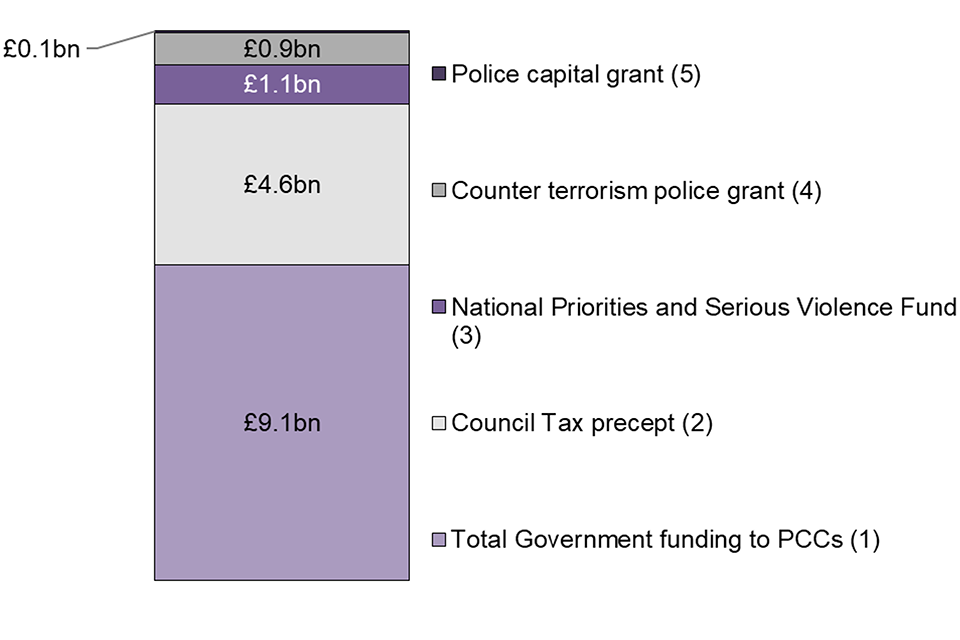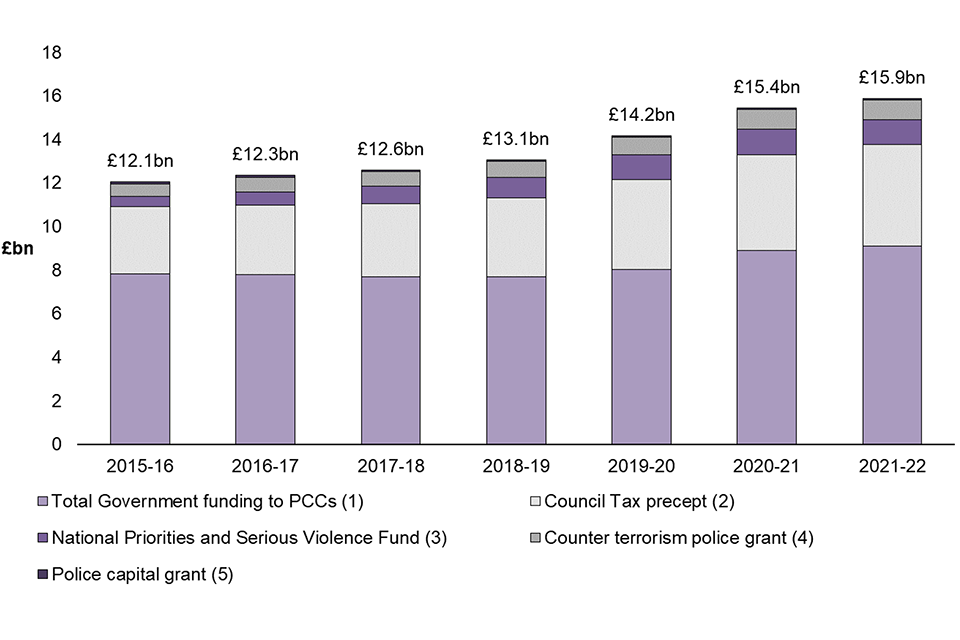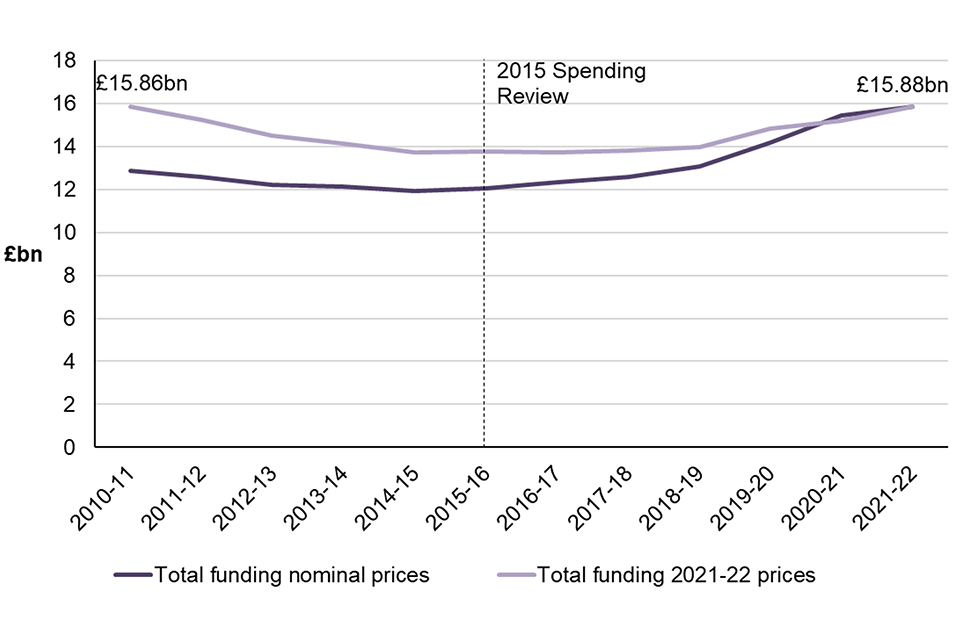Police funding for England and Wales 2015 to 2022
Published 15 July 2021
Applies to England and Wales
Frequency of release: Annual
Forthcoming releases: Home Office statistics release calendar
Home Office responsible statistician: John Flatley
Press enquiries: pressoffice@homeoffice.gov.uk
Telephone: 0300 123 3535
Public enquiries: crimeandpolicestats@homeoffice.gov.uk
Introduction
This release contains information on agreed police funding in England and Wales between the financial years ending March 2016 and March 2022. Chapter 3 also contains high level information on funding back to the financial year ending March 2011.
Key findings
- £15,877 million in police funding for England and Wales has been agreed for the financial year ending March 2022
- overall funding has increased nominally by £433m (2.8%) compared with the previous financial year
- funding has grown in real terms for the fifth consecutive year following a decline between the financial years ending 2011 and 2017
- excluding in-year COVID-19 support and Serious Violence funding noted below (and therefore strictly comparing between police funding settlements), funding has increased nominally by £600 million compared with the previous financial year
Note: Funding comparisons are typically made between the annual police funding settlements and do not include in-year adjustments, as timing of settlement allocations happens before the financial year closes. However, an additional £199 million of in-year COVID-19 funding to forces for the financial year ending March 2021 has been included in the overall funding comparison above. The above figures also include £112 million of in-year Serious Violence funding for the financial year ending March 2022, agreed outside of the police funding settlement (up £32 million on the previous year).
1. Introduction
The structure of Government funding for policing is set at Spending Reviews (where the Government determines how it will fund public services over several years), whilst the detail is outlined and agreed annually. The majority of public funding for the police forces in England and Wales is provided by the Home Office and is agreed by the UK Parliament on an annual basis at the police funding settlement.
Each year the Home Office publishes a Police Grant Report which is published and voted on by Parliament and contains grant funding allocations for the following year to be paid out under the Police Act 1996. The Home Office accompanies publication of the Police Grant Report with a Written Ministerial Statement (WMS) providing context and further information on funding not set out through the Police Grant Report, such as Council Tax precept.
The funding set out in the WMS and the Police Grant Report is collectively referred to as the “police funding settlement”.
In addition to central Government funding, Police and Crime Commissioners (PCCs) set a local police precept which is part of Council Tax. Police precept accounts for around 34% of the funding PCCs directly receive via the settlement and is paid directly by local taxpayers.
This publication contains analysis of published figures from the police funding settlement, in-year funding, and Council Tax precept figures by the Ministry of Housing, Communities and Local Government (for English forces) and the Welsh Government (for Welsh forces).
This bulletin is focused on the main elements of police funding as set out to the UK Parliament each year as part of the annual police settlement process, plus any significant in-year funding announced after the settlement had been agreed. Therefore, the funding considered here does not therefore constitute the whole budget for policing either in a particular Police Force Area, policing body or overall.
For more information about the scope of this publication, definitions and quality considerations, please consult our user guide.
Since the last publication in July 2020, the Office for Statistics Regulation (OSR) has carried out an assessment of compliance with the Code of Practice for Statistics on these statistics. The OSR have published their findings in a report and have identified a number of ways in which the statistics should be developed to meet the highest standards of the Code of Practice for Statistics and achieve National Statistics status. Working with the OSR, Home Office statisticians have reviewed this report and enacted a number of changes to meet these requirements. At the time of publication a decision on whether or not these improvements have been sufficient for these statistics to be designated as National Statistics has not been reached.
2. Overall police funding since financial year ending March 2016
Police funding in the financial year ending March 2022
For the financial year ending March 2022, an allocation of £15,877 million has been agreed in police funding for England and Wales. This represents a nominal increase of £433 million compared with the previous year, equivalent to 2.8%.
This total consists of both police resource and capital funding. Resource funding includes: Government funding to PCCs (including additional funding for responding to new challenges faced by policing during the COVID-19 pandemic); police precept; funding for national priorities (including the Serious Violence Fund from the year ending March 2020); and counter-terrorism police funding. Figure 2.1 below shows the funding for each of these areas for the financial year ending March 2022.
Since the publication of last year’s statistics and the latest police funding settlement in February 2021, an additional £199 million of in-year COVID-19 funding to PCCs for the financial year ending March 2021 has been confirmed. This funding reimburses forces for the cost of purchasing additional personal protective equipment and includes an Income Loss Recovery Scheme for forces to recover relevant lost income on expected sales, fees and charges against their budgets as a result of the pandemic. Due to the inclusion of this in-year funding in these statistics, year-on-year funding increases in this publication differ from those included in the latest Police Grant Report.
Figure 2.1: Overall annual police funding, financial year ending March 2022

In the year ending March 2022 Government funding to PCCs totalled £9.1 billion. Council tax precept totalled £4.6 billion and National Priorities £1.1 billion. Counter terrorism funding totalled £0.9 billion and the Police capital grant £0.1 billion.
Source: Table 1a
Notes: Numbers (1) to (5) in the chart correspond to lines marked (1) to (5) in Table 1a, indicating how the different elements of funding sum to the overall total. Table 1a provides a further, more detailed breakdown of these funding streams. For full definitions of each funding stream included, please refer to the glossary in the accompanying user guide.
Of the main funding streams, Council Tax precept income has seen the largest growth in both nominal and percentage terms increasing by 5.7% against the financial year ending March 2021, or £253 million.
Council Tax referendum principles are set each year for PCCs in England by the MHCLG. These set a level above which an increase in Band D bill level triggers a local referendum. The principles for the latest financial year were that an increase above £15 for an equivalent Band D property would trigger a local referendum. Most PCCs chose to increase their precept level by £15 this year.
Government funding to PCCs, which makes up the largest proportion of the funding settlement, has seen an additional £215 million increase compared with the last financial year. This was driven by a nominal increase of 6.3% in core grant funding to PCCs.
For the reasons explained earlier in this chapter (the inclusion of in-year COVID-19 support funding in these statistics), this differs from the £415 million increase in Government funding to PCCs stated in the latest police funding settlement.
Whilst Government funding and Council Tax precept funding to PCCs has increased compared with the financial year ending March 2021, funding for national priorities (including Serious Violence funding) and police capital funding decreased by 4.7% and 15.0% respectively.
Police funding since the financial year ending March 2016
Since the financial year ending March 2016, overall police funding has increased nominally by £3,816 million, equivalent to 32%. Figure 2.2 below shows the overall total of police funding each year in nominal terms.
Figure 2.2: Overall annual police funding since financial year ending March 2016 (nominal)

Funding has increased nominally from £12.1 billion in the year ending March 2016 to £15.9 billion in the year ending March 2022. Growth has been particularly strong in the last three years increasing from £13.1 billion in the year ending March 2019.
Source: Table 1a
Notes:Numbers (1) to (5) in the chart correspond to lines marked (1) to (5) in Table 1a, indicating how the different elements of funding sum to the overall total. Table 1a provides a further, more detailed breakdown of these funding streams. For full definitions of each funding stream included, please refer to the glossary in the accompanying user guide.
Overall police funding (including funding for PCCs and national priorities) has increased nominally every financial year since the year ending March 2016.
Over this period, Council Tax precept has seen the largest nominal growth, increasing from £3,105 million to £4,649 million.
In contrast, Government funding to PCCs remained fairly stable between the financial years ending March 2016 and March 2019. Since then, Government funding to PCCs has increased year on year, driven by investment in the Police Uplift Programme (resulting in increases to core funding and Police Uplift Programme grants) and the introduction of pension grants.
First announced by HM Treasury as part of the 2019 Spending Review, an in-year grant commenced in the financial year ending March 2020 to support the recruitment of new officers as a part of the Police Uplift Programme. The programme aims to deliver the manifesto commitment to recruit an additional 20,000 police officers in England and Wales by 31 March 2023. This Police Uplift Programme Grant however does not represent the full extent of the funding for the Police Uplift Programme. The majority of funding for the Police Uplift Programme is included within core grant funding to PCCs, whilst a proportion is ring-fenced outside of the core grant. The nominal size of the ringfence has varied each year of the programme, though the proportion has remained relatively stable. The Home Office produce statistics on a quarterly basis monitoring the progress of the programme.
Home Office funding for national priorities (including Serious Violence Fund) has also seen large increases since the year ending March 2016, from £449 million to £1,145 million. Since the year ending March 2019, this has included a new Serious Violence fund and County Lines and Social Media hub funding, totalling £151 million in the latest year.
3. Police funding before the financial year ending March 2016 and real terms changes in funding
The Government regularly reviews how it will fund public services in the years ahead in exercises known as Spending Reviews. As a result of these reviews, the structure of police funding can change significantly with specific programmes or policing bodies moving between being funding from within or outside the police funding settlement announced each year to Parliament.
It is difficult to make direct comparisons between current police funding figures and those in the years prior to the financial year ending March 2016 due to a number of significant changes in the structure of police funding and policing over the period.
Figure 3.1, however, provides a high-level overview of total annual funding since the financial year ending March 2011. Whilst effort has been made to maximise comparability, consideration should be given to the changes in funding structure detailed in our user guide.
Breakdowns of individual funding streams prior to the year ending March 2016 are however not included in this publication.
Figure 3.1: Overall annual police funding since financial year ending March 2011 (nominal and real terms)

Nominally, police funding has increased from £12.89 billion to £15.88 billion between the financial years ending 2011 and 2022. In real terms this represents a slight increase from £15.86 billion to £15.88 billion.
Source: Table 4
Notes: Figures have been converted to real terms using the latest GDP deflators available at time of publication (published July 2021). Due to the COVID-19 pandemic, there is increased uncertainty in OBR’s GDP deflator forecasts. This publication will not be updated periodically to reflect any ongoing changes to this forecast. For further information, please refer to the glossary in the accompanying user guide.
Following a slight nominal decline in police funding provided through settlement between the financial years ending March 2011 and March 2015, funding has grown steadily each year since as explained in chapter 2. This has driven an overall nominal increase of 23.1% in police settlement funding since year ending March 2011.
Real terms comparisons
When compared with the previous year, overall police funding (including any in-year adjustments) for the financial year ending March 2022 has increased by 4.5% in real terms. This is the fifth consecutive year in which police funding has increased in real terms. This follows a steady real term decline between the years ending March 2011 and March 2017.
As a result of the recent real terms increase, police funding (as described in the funding settlement) is now at a similar level seen in the financial year ending March 2011, with a 0.1% increase in real terms between the financial years ending March 2011 and March 2022. This is not necessarily reflective of total police funding over this period due to the reasons described at the beginning of this chapter.
